An Epicurean Adventure to India: Discovering the Comfort of Oven-Baked Chicken Pasanda
Embark on a culinary journey to the heart of India with our exquisite recipe for Oven-Baked Chicken Pasanda. This dish isn’t just a meal; it’s a warm, comforting embrace, a symphony of delicate flavors, and undoubtedly one of our all-time favorite curries to prepare and savor. If you’re seeking a rich, creamy, and incredibly moreish curry that delivers on both taste and convenience, look no further.
Our Chicken Pasanda is a testament to the art of mild Indian cooking, masterfully crafted with the finest ingredients: luscious Greek yogurt, rich double cream, finely ground almonds, and a carefully balanced selection of aromatic spices. What truly sets this recipe apart, however, is its oven-baked approach, transforming it into a mostly hands-off dish. This allows you to relax and enjoy the enticing aromas filling your kitchen, knowing a magnificent feast is effortlessly coming to life.
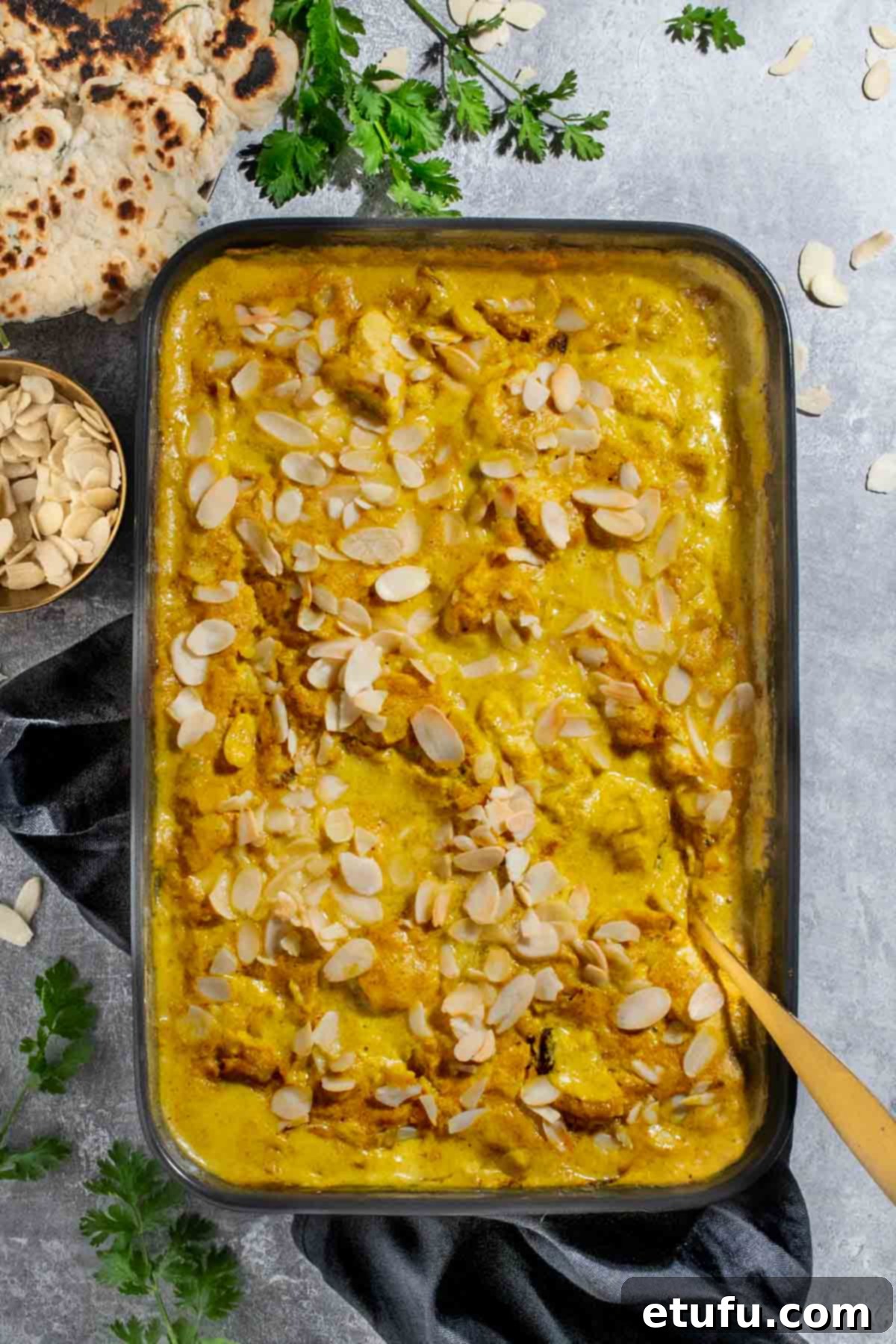
Fast Facts – India: A Land of Flavors and Traditions
India, a land of unparalleled diversity, is not only geographically vast but also incredibly rich in culture, language, and culinary heritage. Understanding a bit about its background enhances the appreciation for dishes like Chicken Pasanda.

| Location | India is a majestic country situated in South Asia, bordered by an array of nations including Pakistan to the west, China, Nepal, and Bhutan to the north, and Bangladesh and Myanmar to the east. Its extensive coastline meets the Arabian Sea, the Indian Ocean, and the Bay of Bengal. |
| Language | A linguistic tapestry, India boasts hundreds of languages. While Hindi and English serve as the official languages for government affairs, the country officially recognizes 21 regional languages. These include widely spoken languages such as Bengali, Telugu, Marathi, Tamil, Urdu, Gujarati, and many others, each reflecting the unique cultural identity of its region. |
| Population | With a population of approximately 1.4 billion people, India is one of the most populous countries in the world, a vibrant melting pot of cultures and traditions. |
| Trivia | Unlike many Western countries that observe four seasons, India traditionally recognizes six distinct seasons in the Hindu calendar. These are the chilly winter (Shishir), the refreshing pre-winter (Hemant), the vibrant spring (Vasant), the warm summer (Grishma), the life-giving monsoon (Varsha), and the colorful autumn (Sharad). This unique perception of seasons profoundly influences local agriculture, festivals, and, of course, regional cuisines. |
Indian cuisine, much like its culture, is incredibly diverse. From the fiery curries of the south to the rich, creamy dishes of the north, each region offers a distinct culinary experience. Pasanda, with its royal Mughal origins, falls into the category of mild, elegant curries often found in Northern India, renowned for its delicate balance of flavors rather than overwhelming heat.
What’s to Love About This Effortless Chicken Pasanda Recipe
Our oven-baked Chicken Pasanda isn’t just another curry; it’s designed for maximum flavor with minimum fuss. Here’s why you’ll fall in love with this recipe:
- Truly Hands-Off Cooking: The greatest advantage of this recipe is the oven. Say goodbye to constant stirring and hovering over a hot stove. Once assembled, simply pop it in the oven and let it do all the work. This frees up your time, allowing you to focus on other tasks, prepare side dishes, or simply relax while your kitchen fills with irresistible aromas. It’s perfect for busy weeknights or when entertaining guests.
- A Family-Friendly Mild Curry: If you love the gentle, creamy notes of a Chicken Korma, you’ll adore this Pasanda. Its mild spice profile, combined with the richness of yogurt and cream, makes it a universally appealing dish, perfect for children and adults alike who prefer flavor without the intense heat. It’s an excellent gateway curry for those new to Indian cuisine.
- Delightful Textural Contrast: The addition of flaked almonds isn’t just for garnish; it provides a wonderful, subtle crunch that beautifully contrasts with the silky-smooth curry sauce. This textural element elevates the dish, making each spoonful an exciting experience.
- A Hint of Sweetness: Raisins are a traditional touch in Pasanda, offering a delicate sweetness that perfectly balances the savory spices and rich creaminess. They melt into the sauce, releasing bursts of flavor that complement the other ingredients without being overpowering. If you prefer, sultanas can be used as an equally delicious alternative.
- Versatile Serving Options: This Chicken Pasanda is incredibly adaptable and pairs beautifully with a wide array of side dishes. From fluffy coconut basmati rice and warm, chewy Peshwari naans to crispy poppadoms with your favorite dips, the possibilities are endless. It’s a complete meal that can be easily customized to your preferences, ensuring every dining experience is unique and satisfying.
Key Ingredient Notes and Smart Substitutions for Your Pasanda
Understanding the role of each ingredient and knowing when to make smart substitutions can elevate your Chicken Pasanda from good to exceptional. Here’s a detailed look at the core components:
*Please refer to the recipe card at the bottom of this post for the complete list of ingredients and precise measurements.
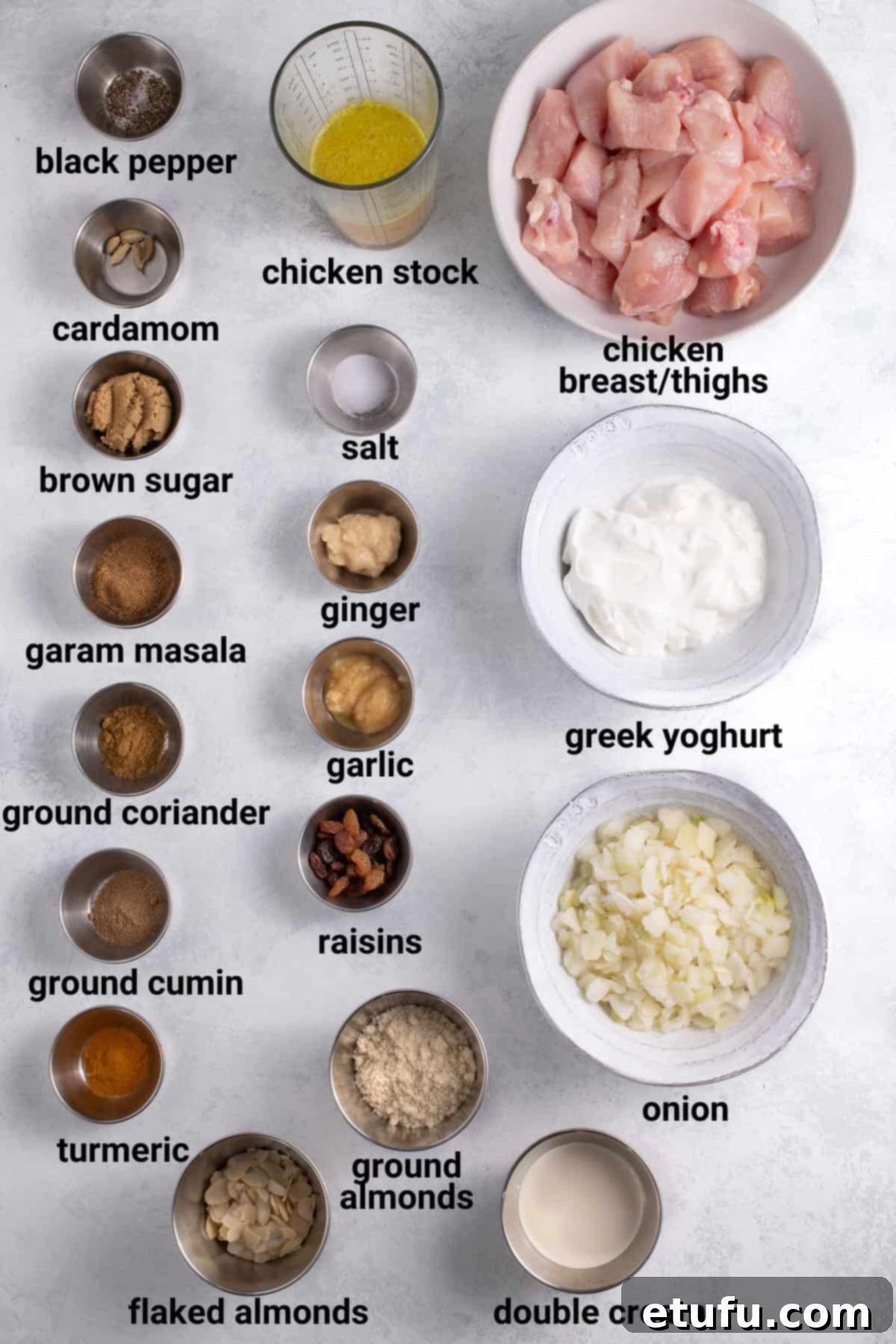
Chicken Selection
For this recipe, you have the flexibility to use either skinless, boneless chicken thighs or chicken breast. While chicken breast offers a leaner option, we highly recommend using chicken thighs. They are inherently more flavorful, tend to remain tender and moist during baking, and absorb the rich curry sauce beautifully, contributing to a more succulent final dish.
Double Cream (or Heavy Cream)
Double cream is a non-negotiable for achieving the authentic richness and velvety texture of Pasanda. Its high-fat content ensures a thick, luxurious sauce that won’t curdle under heat. We strongly advise against substituting it with lighter creams, as they lack the necessary fat content and can result in a thinner sauce and a less satisfying mouthfeel. If absolutely necessary, whipping cream or single cream can be used, but you might need to add a touch more cornflour to help maintain the sauce’s desired consistency and prevent it from becoming too watery.
Chicken Stock
A good quality chicken stock forms the flavorful base of your curry. We recommend dissolving one full stock cube in 150ml of hot water. This not only provides a rich depth of flavor but also contributes sufficient saltiness, meaning you’ll likely need very little, if any, additional salt towards the end of cooking. Always taste and adjust seasoning carefully after the curry has baked.
Greek Yogurt
Full-fat Greek yogurt is key to the creamy tang and body of the Pasanda sauce. Its thickness and higher fat content make it less prone to separating or splitting when heated, ensuring a smooth, cohesive curry. While other plain, full-fat yogurts can be used, avoid low-fat or fat-free varieties. These options are much more likely to curdle or break in the oven, leading to an undesirable texture.
Raisins (or Sultanas)
Raisins provide a subtle, natural sweetness that is characteristic of many Mughal-inspired dishes. They add a delicate balance to the savory and tangy notes of the curry. Feel free to use sultanas as an equally delicious alternative. If you have a sweet tooth, you can increase the quantity to your liking. Alternatively, if you prefer a less sweet profile, they can be omitted entirely without compromising the core flavor of the Pasanda.
Garlic and Ginger
Freshly grated ginger and minced garlic offer the most vibrant and aromatic flavor profile. However, we understand the demands of modern life! For ultimate convenience without sacrificing too much flavor, high-quality pre-made ginger and garlic pastes (available in tubes or tubs) work exceptionally well. We often use them ourselves, and there’s absolutely no judgment here – it’s all about making delicious food accessible.
Optional Enhancements for Intense Flavor
For those who wish to delve deeper into flavor complexity, consider these enhancements:
- Whole Spices: To unlock a more intense and nuanced spice flavor, opt for whole spices where possible and grind them yourself just before use. For instance, freshly ground coriander seeds will offer a brighter, more aromatic note than pre-ground coriander powder. Toasting whole spices lightly before grinding can further amplify their fragrance.
- A Touch of Heat: While Pasanda is traditionally mild, you can easily customize it to your preferred spice level. A pinch of good quality Kashmiri chili powder will add a lovely color and a gentle warmth without excessive heat. For more pronounced spice, finely chopped green chilies can be added to the sauce. Start with a small amount and adjust to taste.
- Freshness Factor: A generous sprinkle of fresh, chopped coriander leaves (cilantro) just before serving is more than just a garnish. It provides a burst of herbaceous freshness that beautifully cuts through the richness of the curry, brightening the overall flavor and adding an essential aromatic finish.
Step-by-Step Instructions: Crafting Your Perfect Chicken Pasanda
Creating this delicious oven-baked Pasanda is simpler than you might think. Follow these clear steps to achieve a perfectly cooked, flavorful curry:
Do the Prep
1. Begin by preheating your oven. Set it to 180℃ (356℉) or Gas Mark 4. This ensures the oven is at the optimal temperature when your curry is ready to bake, leading to even cooking.
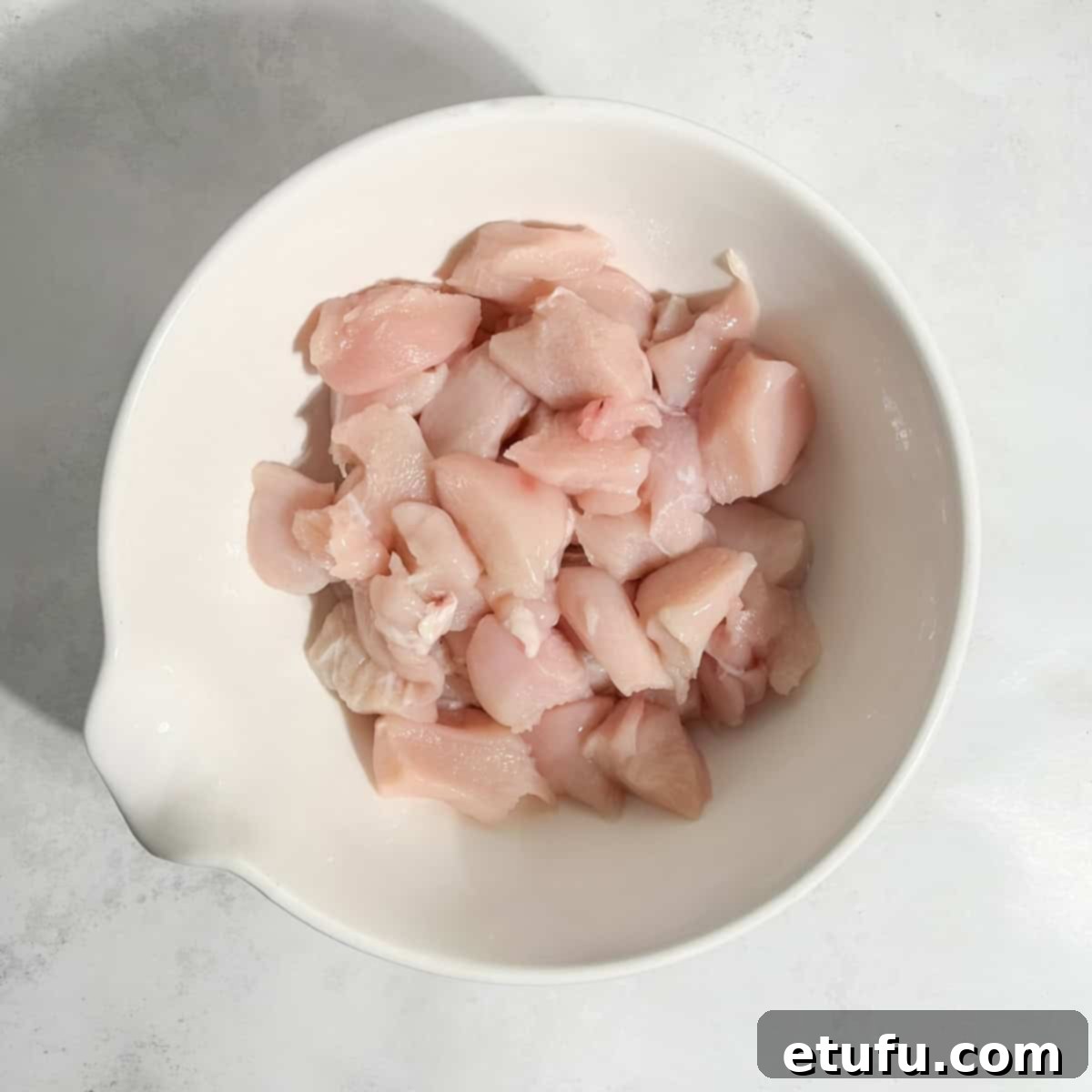
2. Prepare your chicken: Dice the boneless, skinless chicken breasts or thighs into uniform, bite-sized pieces. Aim for pieces roughly 1.5-2 cm (about ¾ inch) in size, which will cook evenly and be easy to eat.
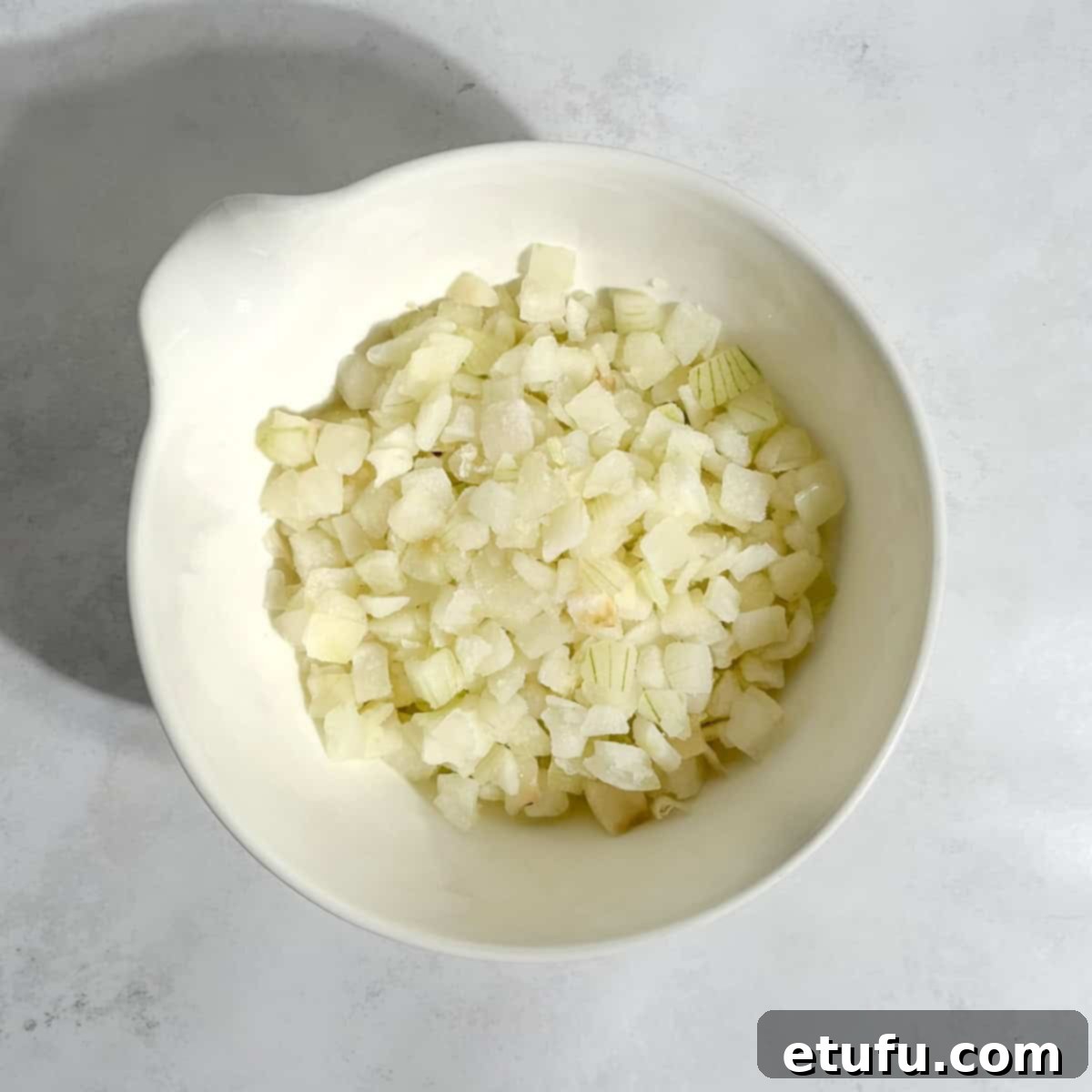
3. Finely dice the onion into pieces approximately 1cm (0.4 inches) in size. Smaller pieces will soften and integrate into the sauce more seamlessly, releasing their sweetness without being chunky.
4. If using fresh ingredients, grate the ginger and mince the garlic cloves very finely. If you’re opting for pastes, measure them out now to have them ready.

5. Carefully remove the tough outer shells of the cardamom pods. These shells are fibrous and not meant for consumption. Finely grind the tiny black seeds inside using a mortar and pestle until they form a coarse powder. This ensures maximum flavor release.

6. In a medium-sized mixing bowl, combine all the ingredients for the Pasanda sauce. Whisk them together thoroughly until they are well combined and the mixture is smooth. This ensures the spices and liquids are evenly distributed, creating a consistent flavor base.
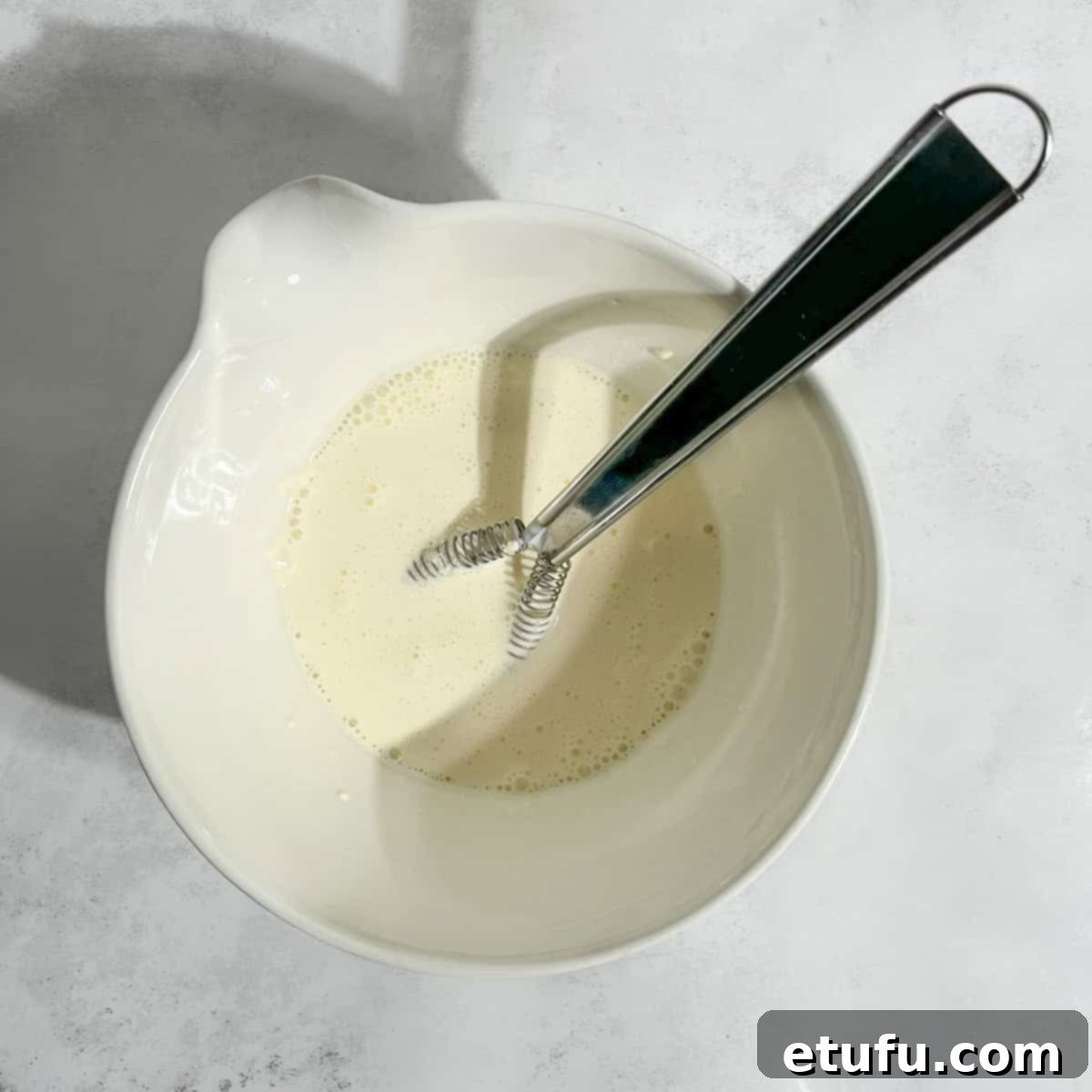
7. In a separate small bowl, combine one teaspoon of cornflour with the six tablespoons of double cream. Whisk vigorously until the mixture is completely smooth and no lumps remain. This cornflour slurry will be added later to thicken the sauce and give it a luxurious finish, so set it aside for now.
Assembling and Baking the Pasanda
8. Arrange the diced chicken pieces evenly at the bottom of an oven-safe baking dish. A dish measuring approximately 25 x 18 x 7cm (10″ x 7″ x 2.5″) is ideal. Ensure the chicken forms a single layer for even cooking.
9. Sprinkle the finely chopped onions evenly over the chicken pieces in the baking dish. They will soften and meld into the sauce as it bakes.
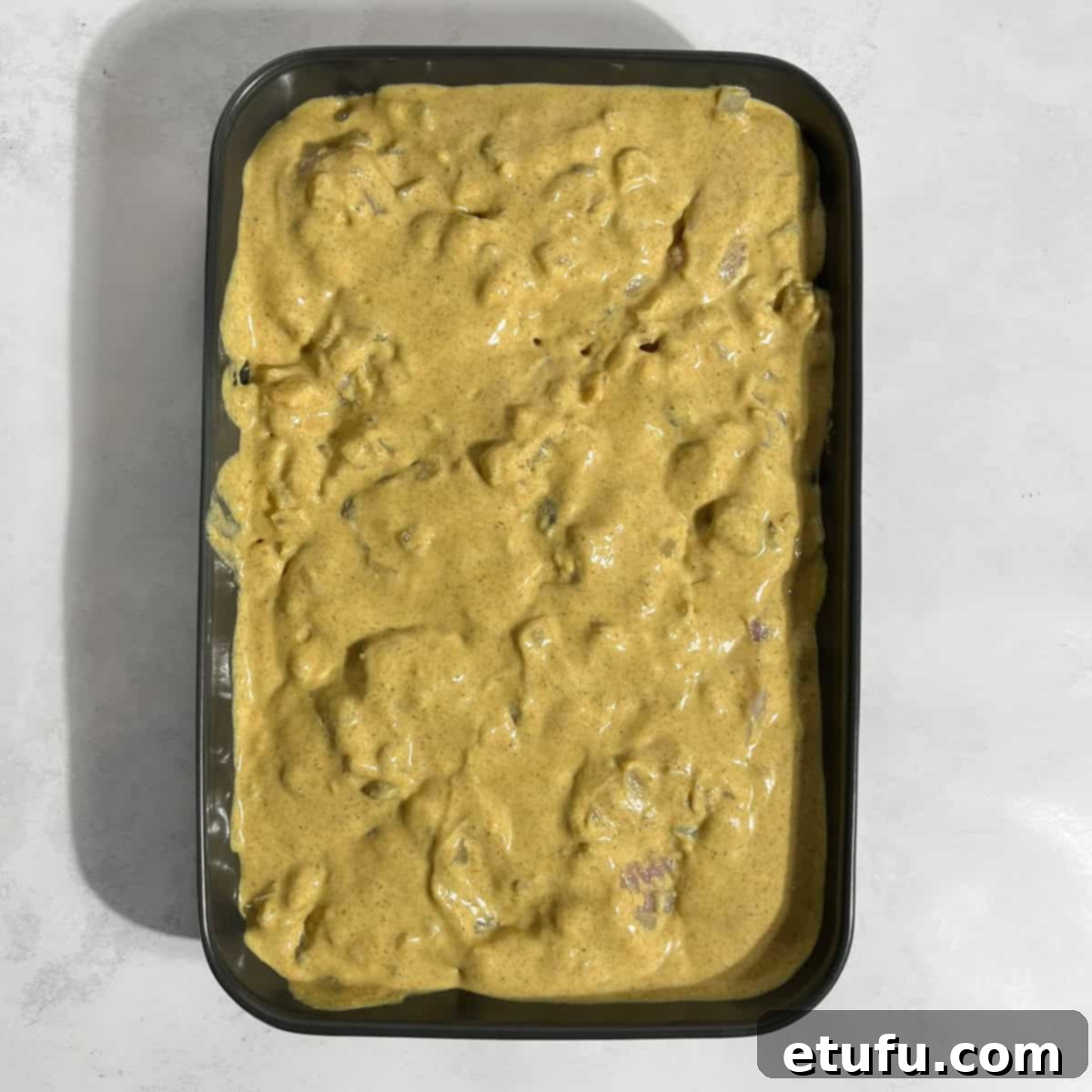
10. Pour the prepared Pasanda sauce over the chicken and onions. Using a fork, gently stir the chicken, ensuring all pieces are thoroughly coated and the sauce reaches the bottom of the dish. This step is crucial for even flavor distribution and to prevent any chicken from drying out.
11. Place the baking dish into the preheated oven and bake for an initial 40 minutes. During this time, the chicken will cook through, and the flavors will begin to meld beautifully.
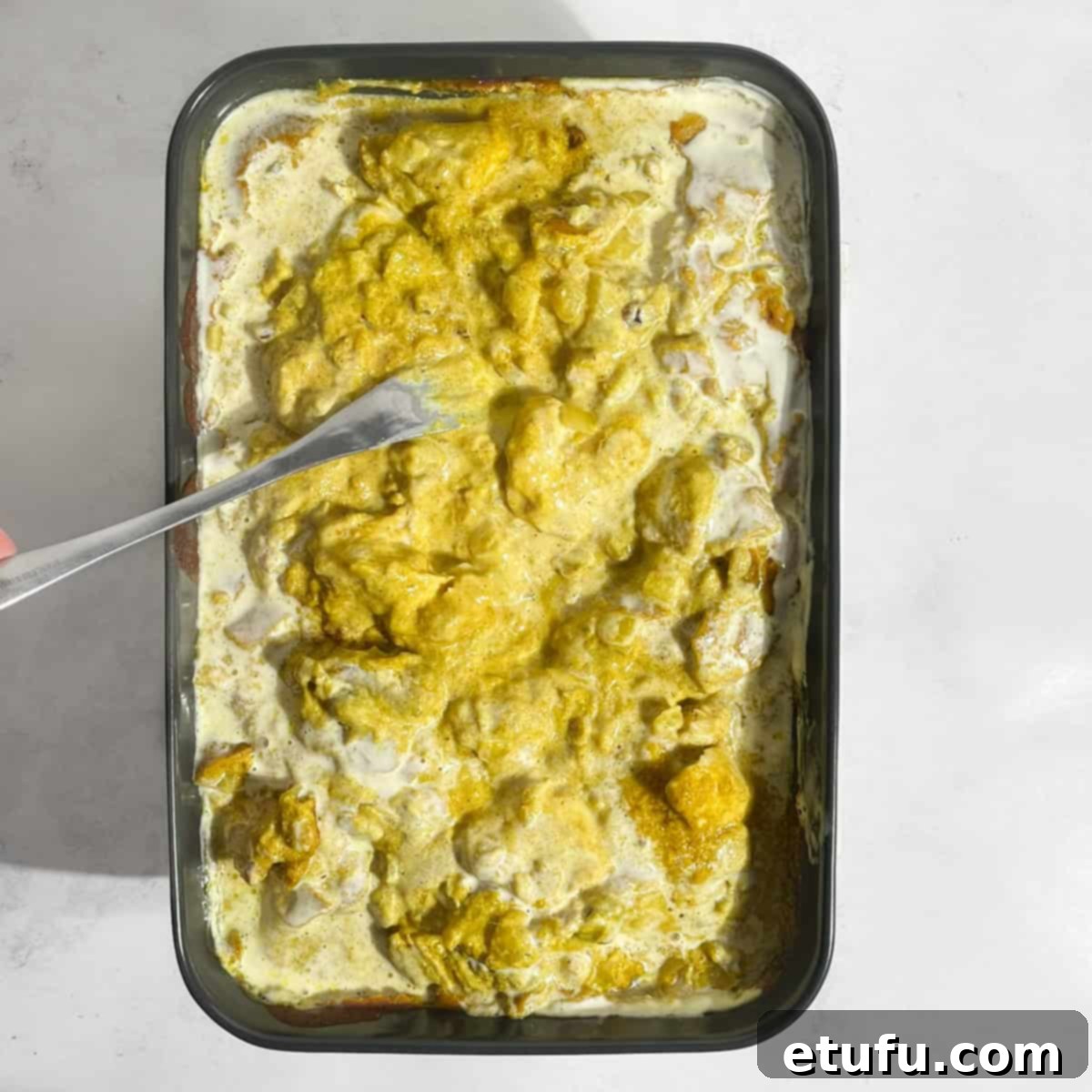
12. After the initial 40 minutes, carefully remove the Pasanda from the oven. Stir in the cornflour-cream mixture you prepared earlier. Use a fork to thoroughly incorporate it into the curry sauce, ensuring it is evenly combined. This will thicken the sauce, giving it the characteristic rich, creamy consistency.
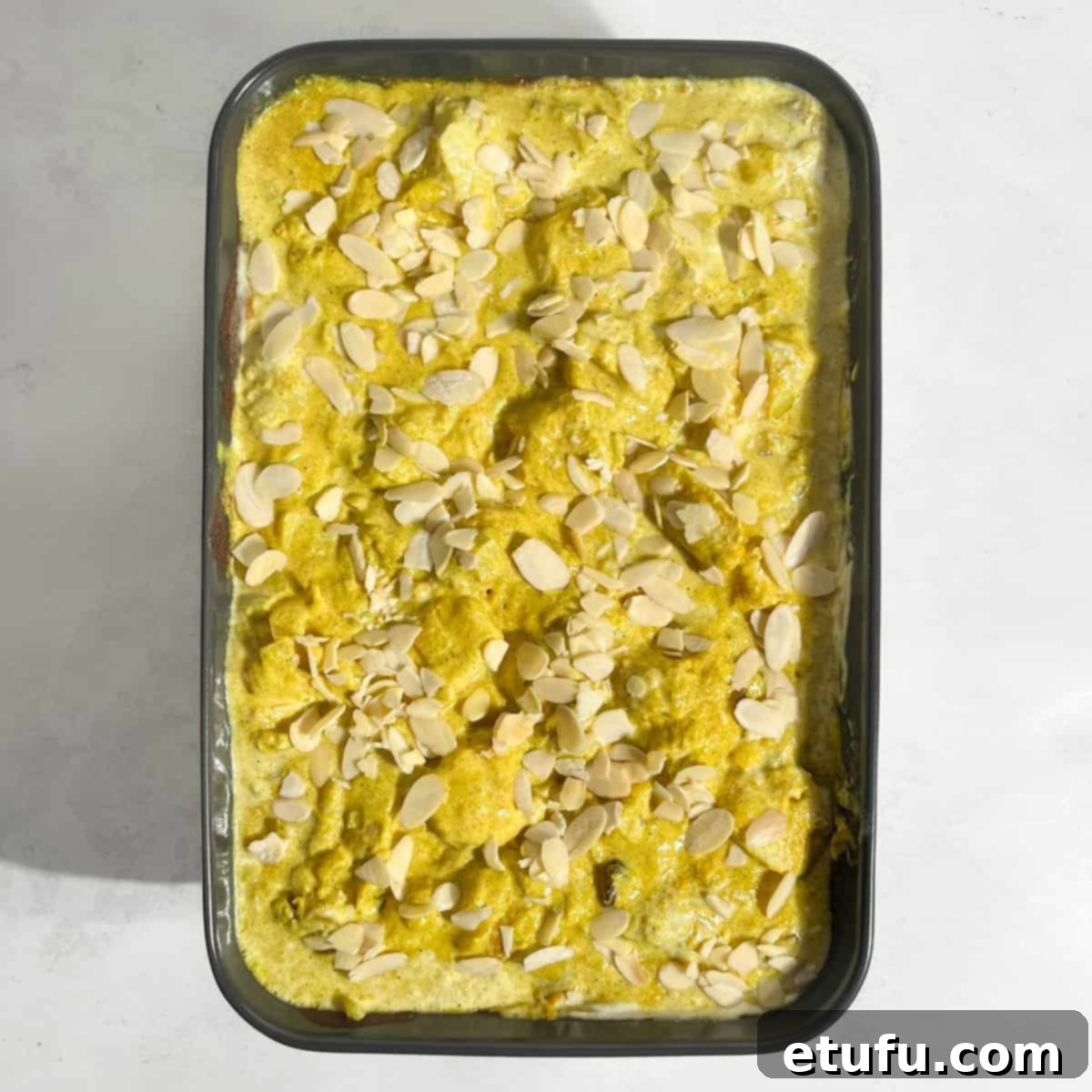
13. Scatter the flaked almonds evenly over the top of the curry. Return the dish to the oven and bake for an additional 15 minutes. This final baking time will allow the sauce to thicken further and the almonds to toast lightly, adding flavor and texture.
14. Once baked, taste the curry and adjust for salt if necessary. Remember that the chicken stock contributes significant saltiness, so add judiciously.
15. Let the Pasanda curry rest for at least 10 minutes after taking it out of the oven. This resting period allows the flavors to deepen and the sauce to settle. Just before serving, give the curry sauce a light, final stir to ensure a perfectly smooth and consistent texture throughout.
Top Tip for a Silky Smooth Sauce
Achieving a perfectly smooth and consistent sauce is key to an authentic Chicken Pasanda experience. It’s crucial to give the Pasanda a thorough stir just before serving. During the baking process, particularly with dairy-based sauces like this one, it’s common for some separation to occur, where the fats and liquids might slightly divide. A good, gentle stir will emulsify the sauce, bringing everything back together and resulting in that desirable, velvety texture and uniform flavor distribution that makes Pasanda so delightful.
Elevate Your Meal: Delicious Serving Suggestions for Chicken Pasanda
Chicken Pasanda is a versatile dish that shines brightest when paired with complementary sides. Here are some ideas to create a truly memorable Indian feast:
- For the Heat Seekers: While Pasanda is mild, you can cater to all palates. Offer a small bowl of freshly chopped green chilies on the side, allowing guests to add an extra kick if they desire.
- Extra Crunch: To amplify the delightful textural contrast, serve an additional bowl of lightly toasted flaked almonds. This is highly recommended for those who love an extra layer of crunch in their curry.
- Freshness Boost: A sprinkle of vibrant, fresh chopped coriander (cilantro) over each serving adds a burst of freshness and an appealing visual touch.
- Rice Varieties: Classic choices include plain basmati rice, but for an aromatic twist, try coconut basmati rice, fragrant pilau rice, or vibrant yellow basmati rice. Each offers a different aromatic dimension.
- Indian Breads: Scoop up every last drop of that creamy sauce with warm, freshly baked naan bread (especially Peshwari naan for a sweet counterpoint) or traditional roti.
- Refreshing Salad: A simple, crisp side salad of cucumber and tomato, perhaps with a light lemon dressing, provides a refreshing contrast to the richness of the curry.
- Chutneys Galore: Offer a selection of sweet and savory chutneys, such as a tangy mango chutney, cooling mint chutney, zesty cold onion chutney, or a rich tamarind chutney.
- Pickle Power: Don’t forget a selection of Indian pickles – lime pickles, mixed vegetable pickles, or mango pickles add a pungent, spicy, and tangy kick that truly awakens the palate.
- Vegetable Sides: Complement your Pasanda with vegetable dishes like sautéed spinach, roasted cauliflower, cauliflower rice, comforting dahl, crisp roasted tenderstem broccoli, or a simple mixed vegetable curry.
- Crispy Poppadoms: No Indian meal is complete without light and crunchy poppadoms, perfect for dipping.
- Cooling Drink: A refreshing strawberry lassi or a traditional plain lassi makes for a wonderful palate cleanser and cooling beverage.
- Sweet Ending: For an authentic Indian dessert, consider serving Firni, a delicious rice pudding, to round off your meal.
Storage Solutions for Your Chicken Pasanda
One of the best things about curries is how well they store and often taste even better the next day! Here’s how to properly store and reheat your Chicken Pasanda to enjoy its flavors again.
Fridge Storage
To keep your Pasanda curry fresh, allow it to cool completely to room temperature first. This is crucial for food safety and preventing condensation. Once cooled, transfer the curry into an airtight container and store it in the refrigerator. It will remain fresh and delicious for up to three days.
Reheating from the Fridge
When you’re ready to enjoy your Pasanda again:
- Stovetop Method: Transfer the refrigerated curry to a saucepan or pot. Heat it over medium-low heat, stirring occasionally, until it is thoroughly heated through. Add a splash of water or stock if the sauce appears too thick.
- Microwave Method: Place the curry in a microwave-safe dish. Cover it with a microwave-safe lid or microwave-safe plastic wrap, leaving a small corner vented for steam to escape. Heat in short intervals (1-2 minutes), stirring well between each interval, until the curry is piping hot throughout.
Freezing for Longer Storage
If you wish to extend the life of your Pasanda, freezing is an excellent option. Once the curry has cooled completely, divide it into freezer-safe containers or heavy-duty zip-top bags. Ensure there’s minimal air in the containers to prevent freezer burn. Label with the date. Frozen Pasanda can be stored for up to three months. This makes it perfect for meal prepping and having a delicious homemade meal ready on demand.
Reheating from the Freezer
To reheat frozen Pasanda:
The safest and best method is to transfer the frozen curry from the freezer to the refrigerator and allow it to thaw overnight. Once fully thawed, follow the stovetop or microwave reheating instructions provided above. Avoid reheating directly from frozen, as this can lead to uneven heating and potentially affect the texture of the sauce and chicken.
Frequently Asked Questions About Chicken Pasanda
Pasanda curry has a rich and royal history, believed to have originated during the opulent Mughal era in India. The Mughals were renowned for their sophisticated culinary traditions, expertly blending Persian and Central Asian cooking techniques with indigenous Indian spices. This fusion led to the creation of many exceptional and widely-loved dishes, including Pasanda. Over centuries, the recipe has been adapted across various regions of India, reflecting the incredibly diverse nature of Indian cuisine, and is particularly popular today in North India for its mild, creamy character. The word “Pasanda” itself comes from the Hindi-Urdu word “pasande,” which literally translates to “favorite” or “loved one,” perhaps indicating its favored status among Mughal emperors or the choice cuts of meat traditionally used.
While chicken is a popular choice today, Pasanda was traditionally made with thin strips of prime cut goat meat. The name “Pasanda” actually refers to these tender strips of meat, typically from the leg of lamb or goat, that were historically marinated and slow-cooked. Besides chicken and goat, you can certainly adapt this recipe to use other meats such as lamb, beef, or even king prawns for a seafood variation. For lamb or beef, you might need to adjust cooking times to ensure the meat is fork-tender.
Absolutely! Pasanda is wonderfully adaptable for vegetarian and even vegan diets. For a vegetarian version, you can create a Paneer Pasanda by using cubes of paneer (Indian cheese) instead of chicken. Paneer holds its shape well and soaks up the creamy sauce beautifully. Alternatively, hearty vegetables like potatoes, sweet potatoes, cauliflower, or mixed vegetables can be used. To make it vegan, swap the dairy cream for a plant-based cream (such as cashew cream or coconut cream) and use a plant-based yogurt. Ensure your chicken stock is replaced with vegetable broth.
While both Pasanda and Korma are mild, creamy Indian curries popular in Mughlai cuisine, they have distinct characteristics. Korma often features a slightly sweeter, richer sauce, typically made with cream, yogurt, and sometimes coconut milk, often incorporating a significant amount of ground cashews or almonds for thickness and sweetness. Pasanda, while also creamy and mild, often highlights flaked almonds and can have a more nuanced spice blend, sometimes including a hint of tang from yogurt and a subtle sweetness from raisins. Pasanda traditionally referred to the specific cut of meat, while Korma refers more to the cooking method (braising). Both are excellent choices for those who prefer milder curries.
More Irresistible Curry Recipes You Might Enjoy
If you’ve loved this Chicken Pasanda, explore more delicious curry creations from our kitchen:
- Bobotie – A Traditional South African Recipe
- Quick Chicken Karahi
- Homemade Butter Chicken Pies (Mini Chicken Pies)
- Curry Noodle Salad (Kerrie Noedelslaai)
Full Recipe Card
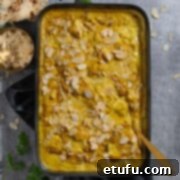
Oven-Baked Chicken Pasanda Curry
Print Recipe
Equipment
- 1 oven dish of circa 25 x 18 x 7cm (10″ x 7″ x 2.5″)
- Medium mixing bowl
- Small bowl for cornflour mixture
- Whisk
- Mortar and pestle (optional, for whole cardamom)
Ingredients
- 600 grams chicken breast or thighs – skinless and boneless, diced into bite-sized pieces
- 150 grams onion – finely chopped (approx. 1cm pieces)
- 6 tablespoons double cream – 90ml, divided for sauce and cornflour mixture
- 1 teaspoon cornflour
- 3 tablespoons flaked almonds – for garnish
For the Pasanda Sauce
- 150 millilitre chicken stock – made with 1 full stock cube or low-sodium broth
- 200 millilitre full-fat Greek yoghurt – or plain full-fat yogurt
- 2 teaspoons garam masala
- 1 teaspoon ground coriander
- 1 teaspoon ground cumin
- ½ teaspoon turmeric
- 5 cardamom pods – seeds removed and finely ground
- 2 teaspoons grated ginger – or ginger paste
- 2 teaspoons minced garlic – or garlic paste
- 1-2 tablespoon raisins – or sultanas, adjust to taste
- 4 tablespoons ground almonds
- 1 tablespoon brown sugar
- ¼-½ teaspoon salt – or more to taste, depending on stock saltiness
- few grinds black pepper
Instructions
- Preheat your oven to 180℃/356℉/gas mark 4.
Prepare Your Ingredients (The Prep)
- Dice the chicken breasts or thighs into uniform, bite-sized pieces.
- Dice the onion quite finely, aiming for roughly 1cm (0.4-inch) pieces for better integration into the sauce.
- If using fresh ginger and garlic, grate the ginger and mince the garlic cloves. (Convenient pastes work just as well!)
- Remove the outer shells from the cardamom pods and finely grind the inner seeds using a mortar and pestle.
- In a medium bowl, whisk together all the ingredients listed “For the Pasanda Sauce” until thoroughly combined and smooth.150 millilitre chicken stock, 200 millilitre full-fat Greek yoghurt, 2 teaspoons garam masala, 1 teaspoon ground coriander, 1 teaspoon ground cumin, ½ teaspoon turmeric, 5 cardamom pods (ground), 2 teaspoons grated ginger, 2 teaspoons minced garlic, 1-2 tablespoon raisins, 1 tablespoon brown sugar, ¼-½ teaspoon salt, few grinds black pepper, 4 tablespoons ground almonds
- In a small bowl, combine the 1 teaspoon of cornflour with the remaining 6 tablespoons of double cream. Whisk until perfectly smooth, then set this mixture aside. This will be added later for thickening.6 tablespoons double cream, 1 teaspoon cornflour
Assemble and Bake Your Pasanda
- Place the diced chicken pieces evenly in your oven dish (approx. 25 x 18 x 7cm / 10″ x 7″ x 2.5″).600 grams chicken breast or thighs
- Sprinkle the finely chopped onions evenly over the chicken.150 grams onion
- Pour the prepared Pasanda sauce over the chicken and onions. Gently stir with a fork to ensure all chicken pieces are well coated and the sauce is evenly distributed, reaching the bottom of the dish.
- Bake for 40 minutes in the preheated oven.
- After 40 minutes, carefully remove the Pasanda from the oven. Stir in the cream-cornflour mixture thoroughly with a fork to incorporate it evenly into the sauce, which will begin to thicken.
- Scatter the flaked almonds over the top of the curry. Return to the oven and bake for an additional 15 minutes, allowing the sauce to thicken further and the almonds to toast lightly.3 tablespoons flaked almonds
- Taste the curry and adjust for salt if needed.
- Let the curry rest for at least 10 minutes before serving. Give the sauce a light stir just before serving to ensure an even and creamy consistency.
Notes
Top Tip
It’s crucial to give the Pasanda a thorough stir before serving.
The sauce can sometimes separate slightly during cooking due to the dairy. Stirring it well will help achieve a beautifully smooth and consistent texture throughout your delicious curry.
**Nutritional Data Disclaimer**
Please be aware that the nutritional information provided below is an estimate calculated by a third party and we cannot guarantee its complete accuracy. We strive to offer the most accurate information possible, but we do not take responsibility for any potential errors. The nutritional value of this recipe may vary depending on the exact brands, types, and quantities of ingredients used. For personalized dietary advice, we recommend consulting with a qualified healthcare professional or a registered dietitian.
Nutrition Information (Estimated per serving)
For comprehensive food safety advice, including guidance on food allergies and handling, please refer to official guidelines.
More Delightful Curry Recipes to Explore
Craving more aromatic and flavorful curries? Dive into these other popular recipes:
Chicken Dopiaza – A rich curry featuring double the onions for a unique flavor.
Nepalese Chicken Curry – Our most popular curry recipe, known for its vibrant spices and hearty texture!
Creamy Butter Bean Curry with Coconut Milk – A fantastic vegetarian option that’s incredibly satisfying.
Aromatic Beef Curry with Coconut Milk – A deeply flavorful beef curry that pairs perfectly with fluffy rice.
Easy South African Bobotie – A unique and comforting baked savory dish with a curried mince base.
Quick Chicken Karahi – A fiery and fresh Pakistani-style chicken curry cooked in a wok.
Curry Noodle Salad – A refreshing and flavorful salad with a delicious curry dressing.
Chicken Handi Curry – A traditional rich and creamy chicken curry cooked in a ‘handi’ pot.
Or, for a deeper understanding of the building blocks of these dishes, read all about Spices here!
Effortless One-Pot Recipes for Busy Days
If you appreciate the convenience of an oven-baked dish like Pasanda, you’ll love these other easy one-pot recipes designed for minimal cleanup and maximum flavor:
Creamy Butter Bean Curry with Coconut Milk – A hearty and simple one-pot vegetarian meal.
Easy Mince and Dumplings – A classic comforting dish, all cooked in one pot.
Nepalese Chicken Curry – A vibrant and flavorful chicken curry, perfect for a single pot.
Beef Trinchado – A zesty, Portuguese-inspired South African beef stew that cooks beautifully in one pot.
Beef Curry with Coconut Milk – Rich and aromatic, ideal for a set-it-and-forget-it meal.
Easy Chicken and Chorizo Jambalaya – A flavorful and filling rice dish, all cooked in one pot.
